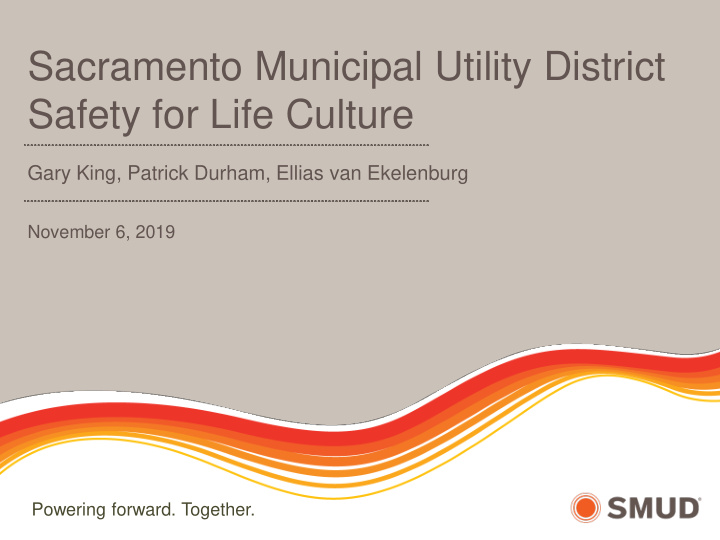



Sacramento Municipal Utility District Safety for Life Culture Gary King, Patrick Durham, Ellias van Ekelenburg November 6, 2019 Powering forward. Together. Powering forward. Together. Powering forward. Together.
Agenda – October 09, 2019, Safety for Life Culture Introductions All New Safety Efforts at SMUD - Gary King - Chief Workforce Enterprise Services Overview Officer Patrick Durham – Director of Environmental, Safety, Safety for Life Culture and Real Estate Services Ellias van Ekelenburg – Safety Manager Safety for Life Road Map and Challenges
Safety Leadership – 2019 to Future • Our North Star - Be Safe. Always. • Outcomes - “…make every move a safe one for our employees, our customers, and our community.” • 2022 Goal – Zero incidents and Injuries. • Develop a Safety at work, home and play that includes: – All SMUD employees and their loved ones. – Our community (Public Safety). – SMUD contractors and leased employees (Contractor Safety). 3
Changes at SMUD • Desire to improve protection of employees, their families, contractors, and the public. • Reduce overall risk and costs with improved safety. • Succession planning and knowledge transfer. • Infrastructure changes to address customer needs. • Use of more contractors. • Replacement of aging infrastructure. • Supporting new energy demands in a diverse and growing economy.
Safety for Life Culture • Work with employees, Associations (WEI, ORC, EPRI), and other Utilities(SRP, PG&E, LADWP, SCE). • Identified Gaps within SMUD and the industry. • Develop a Safety Roadmap using a Safety for Life Culture. • Engagement with Leadership, Employees, and our Community. 5
Leadership Engagement This stakeholder group is responsible and accountable for worker safety. Leadership drives the Safety for Life culture at SMUD. What to expect from Leadership Engagement: • Integration of health and safety work practices into business planning, project designs, and daily work activities. • Utilizing risk and exposure data to identify improvement opportunities. • Utilizing supervisor-employee interactions to: – Communicate and promote the Safety for Life culture . – Recognize safe work performance. – Identify, assess and control hazards. – Identify roots causes of incidents and following up to ensure effectiveness of corrective actions. – Demonstrating and reinforcing safe behaviors and expectations. 7
Employee Involvement This stakeholder group is typically closest to the risk. By involving all employees in SMUD’s risk reduction efforts, effectiveness of countermeasures and buy-in are increased. Employees share in being accountable for Safety and are encouraged to participate in: • Field Visits & Observations/Inspections. • Training Development and Delivery. • Safety Committees (i.e. SCORCH, JLMSC). • Safety Meetings. • Near Miss Reporting. • Recognition. • Work Procedure Development. • Audits. • Incident Investigations. 8
Community This stakeholder group includes the public, contractors, and leased employees. We act in the collective best interests of our customers and community. What to expect: • Public Safety – Continued Electrical Safety Education & Training with EM responders, schools, contractors, and agricultural workers. – Promote/Create Call before you Dig (811), Look up and Live, Teen Driving, & Yard Safety. – Strengthen EMF/RF programs. – Improved follow-up and metrics on SMUD electrical contact incidents. – Joint table top ER training for Gas Pipeline. – Pole Relocation efforts. – Air quality risk assessments. • Contractor Safety – ISNet contractor selection and review. – Contractor onboarding, field visits, and job closeouts. – Employee, stakeholder, and contract training. – Contractor Safety metrics 9
Benchmarking • EPRI - Case studies and subcommittees • Utilities – IOU and PUDs • Associations – WEI and ORC • Vendors/Contractor Support • KPI Comparisons
Safety Leadership • Incident Review Committee • 5-year Safety Road Map • Communication Plan Development • SMUD-wide Safety Roles & Responsibilities • VPP Effort at the UARP & Gas Pipeline • Health Assessment Program (HAP) Safety Program Changes • Safety E-learning • EMS Electrical Safety Training • Driver Safety with Telemetric Plan Development • Workflow Integration Plan • 5G – RF Safety Plan Review Safety Metrics and Communications • Improved Dashboard for DART Reporting • Electronic Safety Management System • Standards Development & Training • Improved Document Control 10
Safety Compliance • Near Miss Reports with root cause analysis for SIF potential events • Accident/Incident Investigation Training • Job Hazard Analysis – New with Risk Ranking • Field Safety Support • Improved Internal Assessment Process Safety Programs • Safety for Life - Family Days, CPR/First Aid/Situational Awareness • Driver Safety – Driving Skill Competition & Driving Program Improvements • SCORCH – Behavior Based Safety Mini Conference. Over 6k obs. • Corrective Action Follow-up • JLSMC – Pole Relocation, Tool Subcommittee, Tailboard Dev. Contractor & Public Safety • Safety Pre-Qualification of Contractors • Look up and Live Billboard Campaign • Education and Training with First Responders and Schools • Improved EMF and RF Meters and Response Programs • Gas Pipeline Training Exercise/Utility Public Safety Alliance • Working with the City of Sacramento on new pole permitting req. 11
2019 & Beyond New Safety leadership brings SMUD down an untraveled road: - Increased of mobile safety software to conduct: – Inspections / Field Assessments – Incident & Concern reporting – Virtual observations – Hand’s on risk assessments - Further integration of Safety for Life program elements. - Increased field presence of safety professionals, enhanced crew visits. - Advanced use of leading indicator risk reduction metrics.
Challenges to Operations • Trust – Strengthening trust among leadership and employees. • Communication - Safety program changes to field forces, and relevant information to our employees, family, contractors, and the public. • Management and Speed of Change - Too much change too quickly leads to weak implementation. • Resource Allocation – Scheduling and planning the development and implementation of new and revised safety programs and efforts with already busy Business Unit employees. • Technology – Need for better data management systems to improve analysis and data analytics.
Questions & Answers 15
Recommend
More recommend